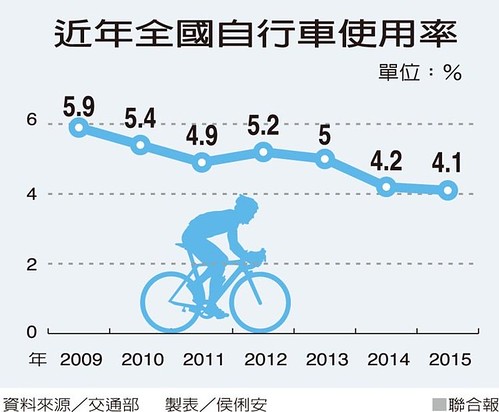
The United Daily the Liberty Times both have reports detailing the Ministry of Transportation's report on a steady decline in bicycle use nationwide.
Taiwan, which often bills itself as the "bicycle kingdom" in promotional material, is experiencing a contraction in the use of public bicycles as well as bicycles for transportation.
The key factor, as pointed out by the Ministry of Transportation, was the easing of fuel prices over the past year, which has encouraged people to opt for the use of personal motorized transportation for shorter trips. Many respondents also cited "convenience" as a factor.
While bicycle use has grown in Taipei, New Taipei City, Hsinchu, Hualien and Pingtung, ridership has fallen elsewhere, negating any gains. According to the data, Yilan, Yunlin, Miaoli, Kaohsiung, Taoyuan, Taichung and Tainan all experienced negative growth in ridership over the past seven years. The Ministry of Transportation feels the expected rise in gas prices could again fuel growth, but some experts are less optimistic.
It is also interesting to look at the areas that experienced the greatest growth and to wonder about infrastructure spending and government subsidies in those areas as they correlate to political alignment.
The study also found that riders between 15-18 years of age were most likely to participate in bike-share programs--a statistic supporting the assertion that Taiwan's bike share programs do little to cut emissions.
In most areas, there is still no real space for bicycles on the roadways, making commuting by bicycle inconvenient, impractical and dangerous.
While Taiwan's bicycle programs have been highly touted in the international press, this report really serves to highlight the disparities between Taiwan's far north, and the rest of the country, as well as how few reporters ever venture out of Taipei.
It could also be that the bike trend is over in Taiwan.

Taiwan will not be a "Bicycle Kindom" unless people start forming advocate groups like the Cascade Bicycle Club, and to tell the governers how to properly pave a bikeway, restrict big trucks on the road, and reduce pollution (assuming that the governers will consider people's suggestions of course).
ReplyDeleteTaiwan's only real bicycle advocacy group is owned by Giant. Giant provides the YouBike system and has also had a representative in the Executive Yuan for the past 8 years. Conflict of interest.
ReplyDeleteWithout looking at the data it would be expected. If you graphed the type of cycle user I'd expect to see "traditional" groups falling, by these I mean the older ladies going to market and running errands. This has been going on for years.
ReplyDeleteThis fall would be offset by growth in new user groups, younger adults trading scooter commute for bike, recreational cycling, and bike shares, and others. The data as reported seems to support that idea.
Tammy San,
ReplyDeleteI think that is a fair observation. I see the largest number of bikeshare riders being high school kids. A few adult commuters, but not many.
I prepared a ride to work scheme for Taichung government many years ago when I wrote their cycling policy. Not one person on the transport department was prepared to ride a bike. Citing no police to control the drivers who se a bike lane as a quick route to the front, no facilities to park bikes at city hall & no changing rooms.
ReplyDeleteIt is, of course, tempting fate to say that I don't feel too endangered when cycling in Tainan, but I'm not sure the danger angle puts people off. If it was the most important factor then surely riding scooters should be a terrifying prospect with the number of scooter accidents anyone can see here every week, but we have the most scooters of all the cities in the country.
ReplyDeleteOne thing that certainly makes me think twice on many days before getting on my bike is the really dangerous atmospheric pollution level.
Other factors that could mentioned concern the laughable attempts to set aside special lanes or pathways. We had a yellow lane down one major road but as soon as it was painted it became an excuse for extensive double-parking which pushed us out towards the centre of the road. I also discovered intermittently marked cycle lanes along both sides of one road which are on the pavement (sidewalk) tight up against all the doorways and, of course, giving the added excitement of competing with waiters between the tables of the restaurants that have spilled out across the path.
I can vouch for the fact that enforcement does work. In the quarter of the city where I live fear has grown among car drivers of the newly privatised tow trucks. As for enforcement by the proper authorities - that continues to be very disappointing.